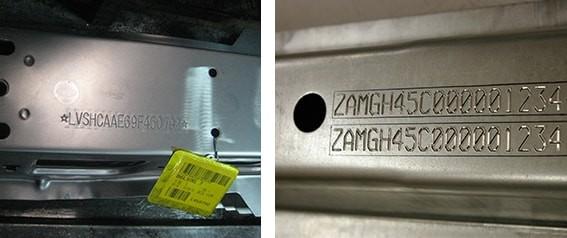VIN code marking on vehicles
What is the VIN code?
VIN stands for vehicle identification number and it is a number to identify each vehicle, it would be a D.N.I. for vehicles under the same world standard (ISO 3833).
This identification is mandatory for any type of vehicle: cars, motorcycles, trucks, trailers and even tractors and agricultural trailers.
The VIN number is composed of seventeen characters and one of its peculiarities is that it does not use the letters “Q”, “O” or “I” to avoid possible confusion with the numbers 1 and 0.
Below, we explain the meaning of each character of the V.I.N. code that can be found in any car or land transport:
- The first 3 characters (WMI) provide information on who manufactured it.
- The following 6 (VDS) describe the characteristics of the vehicle.
- The rest of the characters (VIS) describe characteristics of the model.
Why is the VIN number so important?
Here are the reasons why this identifier is so important in the automotive industry:
- This identifier ensures the traceability of a vehicle, from its manufacture to its subsequent sale.
- As it is a unique code for each vehicle, it is also an element of security as it allows us to know the car’s history.
- Thanks to such traceability, it is possible to know the owners of the vehicle and contact them when there has been a problem with the car parts. An example could be the identification of Volkswagen vehicles that had software installed to alter the results of CO2 emission controls.
Where is the VIN code recorded?
The most common places where we can find the bodywork or parts marked with this identifier are:
- In the lower corner of the windshield.
- Under the hood on the front face of the engine or on the rear frame.
- On the driver’s door frame.
- In the chassis area above the front wheel.
In the case of other transport vehicles such as agricultural tractors, trailers or others, they can be found on the engine, frames or firewalls. In addition, many manufacturers in the automotive sector engrave the VIN on additional parts to provide greater security or reading convenience.
VIN code marking on cars and vehicles
Scratch marking provides a fast, quiet and accurate result. An ideal marking system for VIN marking of automobiles.
The only valid and effective markers to achieve the required depth of VIN code marking are our scratch markers or our 100 W laser, specially designed and manufactured for this specific solution.
The marking must be done with a high quality machine to ensure permanent marking of the metal parts.
V.I.N. code on trailers, trolleys and transport elements
The regulations that apply to trailers, carts, agricultural vehicles, etc. are the same regulations that apply to cars, motorcycles… From 2019 every motor vehicle, new or registered must comply with the Delegated Act in relation to license plates and regulatory markings.
As mentioned above, the VIN number makes no distinction according to the type of vehicle, so it must consist of 17 alphanumeric characters. The VIN number also consists of three sections, WMI, VDS and VIS, which are divided into different parts.
Regulatory plates
In addition to the VIN itself, trailers, wagons, trucks… must display a clearly legible plate containing the following information, in the order indicated below:
– Manufacturer’s name
– Trade name (when different from the manufacturer’s).
– Vehicle category and subcategory.
– EU type approval number.
– The VIN Code
– The maximum laden mass of the vehicle in “kg”.
– The maximum permissible mass per axle.
– In vehicles of category R or S with rigid drawbar or central axle, the vertical load on the coupling point (S), shall be considered the first axle and shall be numbered as “0”, with the following format: “E-0: … Kg”.
V.I.N. code markers
Using high quality machines for VIN marking is essential to ensure permanent marking of the part or body.
- Permanent marking and V-I-N compliant.
- Legible, even after galvanizing and painting processes.
- Easy access for readability and traceability
Types of machines:
- Laptops
- Can be integrated into the lines.
Scratching machine for VIN code marking
SIC Marking i104 100W laser. Thanks to its 100W, it can be used to deepen the material quickly and efficiently.
Our SIC Marking Marking i113S is the right one for marking this type of code.
VIN code reading and traceability
Sivart also offers reading and traceability systems for vehicle identification. Our goal is to offer an efficient, durable and easy-to-use solution for automotive production lines.
Sivart can install Microhawk MV-XX equipments , these equipments are able to read the code marked by our marker. In addition, the vision cameras are not only able to read the marked code, but also to compare it with the code that our marker has marked, receive that information, and compare that code to validate that both information coincide and that the marking has been correct.
